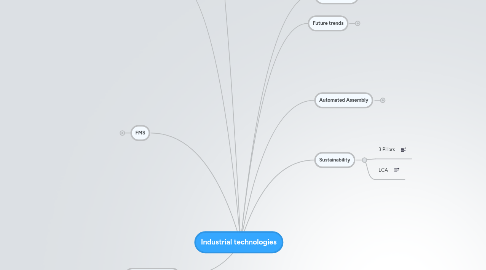
1. Job Shop
1.1. Features
1.2. Strenghts
1.2.1. High Flexibility
1.2.1.1. Product
1.2.1.2. Mix
1.2.1.3. Enlargement
1.2.2. High Elasticity
1.2.3. Low Obsolescence
1.2.4. Low starting cost
1.2.5. Easy knowledge transfer
1.2.6. Low impact of failures / breakdowns
1.3. Weaknesses
1.3.1. Difficult production management
1.3.1.1. High and variable lead times
1.3.1.2. High WIP
1.3.1.3. Low machine use
1.3.1.4. Difficult to estimate lead times
1.3.2. Variability in products
1.3.3. Difficult Capacity estimation
1.4. ORD Overal Rough Design
1.4.1. Define Production Mix
1.4.1.1. Identify all the jobs
1.4.1.2. Estimate yearly demand
1.4.1.3. Calculate lot size
1.4.2. Routing definition
1.4.2.1. Routing for each job
1.4.2.2. Alternate routes
1.4.3. Machine identification
1.4.4. Calculate Tij
1.4.5. Calculate NHi
1.4.5.1. NHi = SUM j=1,N [ Tij*Qj/(3600*(1-DC)) + (STTij/60)*NLj ] * 1/Ai * 1/HCi * 1/TRi
1.4.6. Calculate number of AHi
1.4.6.1. AHi= WHi*SE*ST
1.4.7. Number of machines
1.4.8. Number of shifts
1.4.8.1. TC= WFi(s) + OCi(s) + NMi(s)*CAi*mi + SSTi(s)*fi
2. Manual Assembly Lines
2.1. Fixed Assembly
2.1.1. Strenghts
2.1.2. Weaknesses
2.1.3. Design Guidelines
2.2. Assembly Shop
2.2.1. Strenghts
2.2.2. Weaknesses
2.3. Assembly line
2.3.1. Strenghts
2.3.2. Weaknesses
2.3.3. Types of assembly line
2.3.3.1. Paced
2.3.3.2. Unpaced
2.3.3.3. Continuous
2.3.4. MOSM
2.3.4.1. Precedence diagram
2.3.4.2. Total task T
2.3.4.3. CT
2.3.4.4. Min number of stations
2.3.4.5. Assign tasks to stations until OS reached
2.3.4.6. Performance measure
2.3.5. MPno-C
2.3.5.1. Calculate remaining time RTk
2.3.5.2. Calculate Zk associated to remaining time
2.3.5.3. Find Pk
3. Automated Assembly
3.1. Transfer Lines
3.2. Cells
3.3. Assembly Shop
3.4. Flexible Assembly System
3.5. Evaluation of capacity
3.5.1. Matrixes
3.5.1.1. Machine
3.5.1.2. Operator
3.5.1.2.1. Policies a and b
3.5.1.2.2. Policy c
3.5.1.2.3. Policy d
3.5.1.3. Ii
4. FMS
4.1. Average workload design
4.1.1. Number of machines
4.1.1.1. Workload on machine i
4.1.1.2. Total available time
4.1.1.3. Number of stations type i
4.1.2. Number of transporters
4.1.2.1. Transits matrix
4.1.2.2. Service request
4.2. Queueing theory
4.3. Simulation
5. Production Planning
5.1. Loading Rules
5.1.1. BL1
5.1.2. BL2
5.1.3. BL3
5.1.4. RND
5.1.5. BN2
5.2. Dispatching Rules
5.2.1. SPT
5.2.2. LPT
5.2.3. TSPT
5.2.4. LWKR
5.2.5. TWORK
5.2.6. MSUT
5.2.7. FIFO
5.2.8. LIFO
5.2.9. FISFS
5.2.10. FROP
5.2.11. MROP
6. Sustainability
6.1. 3 Pillars
6.2. LCA
7. Robots
7.1. Components
7.2. Degrees of freedom
7.2.1. Joints
7.3. IP international protection
7.3.1. N1 against solids
7.3.2. N2 against liquids
7.3.3. AL1 protection against access to hazardous parts
7.3.4. AL2 Aditional info related to protection of device
7.4. Tech performances
7.4.1. Speed
7.4.2. Load
7.4.3. Type of movements
7.5. Uses
7.5.1. Pick and place
7.5.2. Packaging
7.5.3. Assembly
7.5.4. Foundry
7.5.5. Welding
7.5.6. Soft materials
7.6. Architectures
7.6.1. Cartesian CCC
7.6.2. Cylindrical PCC
7.6.3. Polar PPC
7.6.4. Articulated PPP
7.6.5. SCARA
8. Future trends
8.1. Servitization
8.2. Mass customization
8.2.1. Standardization
8.2.2. Modularization
8.2.3. Agile manufacturing
8.2.4. Lean manufacturing
